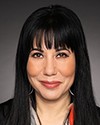I think what it really boils down to are policies and legislation that have accountability mechanisms to hold perpetrators and companies and governments responsible, and also bringing indigenous women and girls and 2S people to the table and centring their voices, and actioning what they are sharing about what prevention and safety look like to them. It's also about providing that equity and equality for meaningful participation when resource development is occurring.
When we look at poverty, it often can lead to the perpetuation of violence as well. If we give opportunities for education, housing, child care and employment, that's what a lot of prevention looks like because we're providing strength-based approaches to supporting indigenous women, girls and 2S people within the communities who are being impacted by resource development.
I also think that there have to be mechanisms put in place and training on violence prevention. What is violence and what is human trafficking and what is sexual exploitation? I mention these because sometimes people do not understand the types of violence occurring out there. It's also an opportunity, even in schools, when there's resource extraction happening, to educate teens and younger children on what violence looks like and what grooming, human trafficking and sexual exploitation look like.
We need to really focus on the education piece, and also on grounding indigenous women and 2S people in who they are and where they come from, and providing those opportunities to anchor themselves in their land, their culture, their language, because these are really strength-based approaches. We know that when resource extraction occurs, it often takes away many of these things.
We also need opportunities for healing because we have been impacted by intergenerational trauma as well.
There are many things that are needed. Those are just some of the things I can share right now in the interests of time, but I could talk for two days on what prevention can look like.
Thank you.





